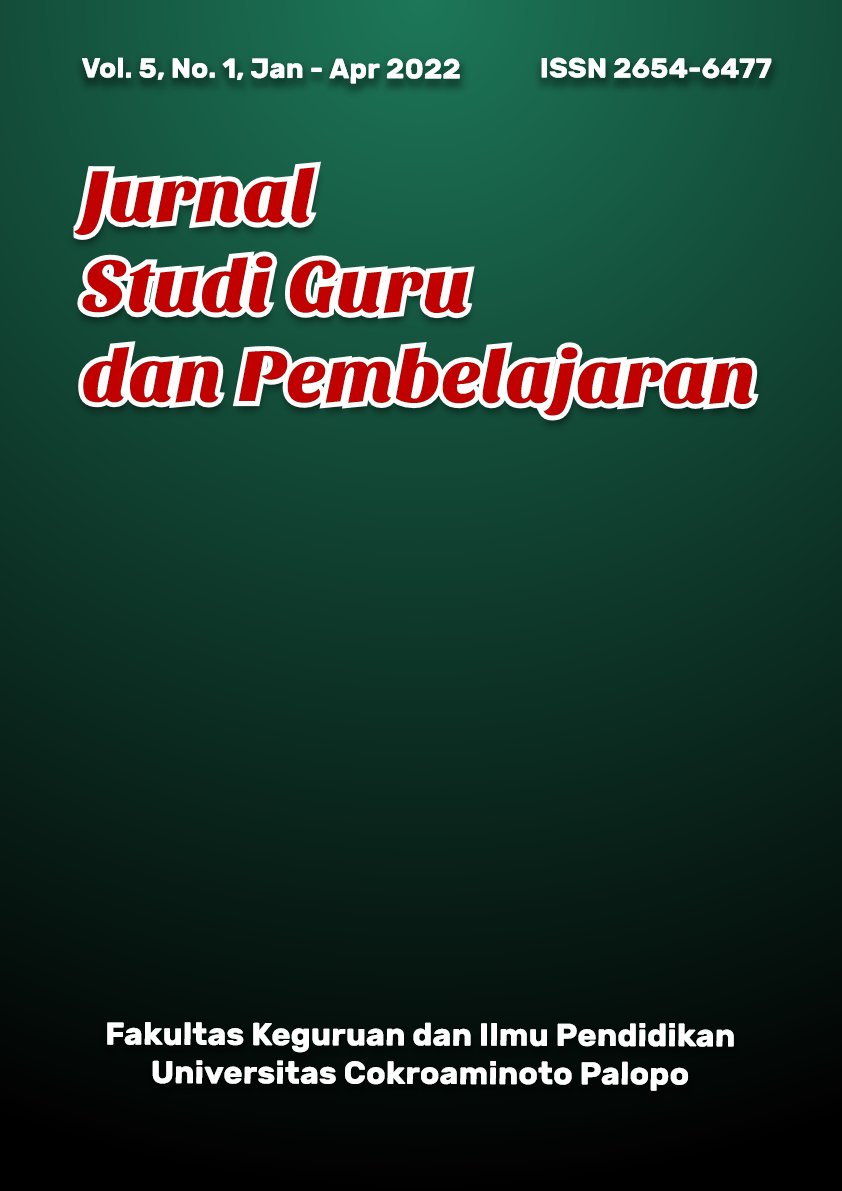Efektivitas Penggunaan Media Audio Visual Terhadap Kecerdasan Spiritual Anak Kelompok B Di TK ABA III Paranga
DOI:
https://doi.org/10.30605/jsgp.5.1.2022.1670Keywords:
Audio Visual, Kecerdasan Spiritual, Efektivitas, Media PembelajaranAbstract
The problem in this study is whether the use of audio-visual media is effective on the spiritual intelligence of group B children in Aisyiyah Bustanul Athfal III Kindergarten, Bajeng District, Gowa Regency with the aim of knowing the effectiveness of using audio-visual media on the spiritual intelligence of group B children in Aisyiyah Bustanul Athfal III Kindergarten Paranga Bajeng District, Gowa Regency. This type of research is an experimental research design using the One Group Pretest-Posttest design which consists of pretest, treatment and posttest. The subjects in this study were 10 children in group B. The results showed that the use of audio-visual media was effective on the spiritual intelligence of group B children in TK Aisyiyah Bustanul Athfal III Paranga which showed that the average pretest score was 7.4 and the posttest average was 16.1 and was also supported by the results of calculations using the Wilcoxon Signed Rank Test on the SPSS program obtained the Asymp value. Sig. (2 tailed) of 0.005, here is a probability of 0.05 or (p < 0.05) which means H0 is rejected and H1 is accepted. Based on the results of this study, it can be concluded that the use of audio-visual media is effective on the spiritual intelligence of group B children at Aisyiyah Kindergarten Bustanul Athfal III Paranga, Bajeng District, Gowa Regency
Downloads
References
Aisy, H. R., Riska, N., & Febriana, R. (2022). Pengembangan Media Video sebagai Edukasi Stunting. Cokroaminoto Journal of Primary Education, 5(1), 134-40.
Authar, N. (2018). Pengaruh Media Audio-Visual terhadap Kecerdasan Spiritual. Aṭfālunā: Journal of Islamic Early Childhood Education, 1(2), 64–70. https://doi.org/10.32505/atfaluna.v1i2.924
Damayanti, U. F. (2019). Pengembangan Kecerdasan Spiritual Anak Melalui Pembelajaran Dengan Penerapan Nilai. 2(Januari), 65–71.
Darmadi. (2018). Kecerdasan Spiritual Anak Usia Dini dalam Cakrawala Pendidikan Islam. Guepedia Publisher.
Daryanto. (2016). Media Pembelajaran (Agus (ed.); Edisi Kedua). Gava Media.
Eriskiani, A. D. (2020). Efektivitas Media Audio Visual dalam Meningkatkan Proses dan Hasil Belajar Anak Usia Dini (Penelitian Tindakan Kelas pada Siswa Kelas A dengan Tema Binatang di RA Muslimat NU 027 Mangunsuman 1 Siman Ponorogo) (Doctoral dissertation, IAIN Ponorogo).
Gabriela, N. D. P. (2021). Pengaruh Media Pembelajaran Berbasis Audio Visual Terhadap Peningkatan Hasil Belajar Siswa Sekolah Dasar. Pendidikan Guru Sekolah Dasar, 2(1), 104–113. https://ummaspul.e-journal.id/MGR/article/download/1750/574
Lilis Midyawati. (2017). Strategi Pengembangan Bahasa Pada Anak. kencana.
Margaretha, L., & Pura, D. N. (2019). Pengembangan Model Media Audio-Visual untuk Meningkatkan Nilai-Nilai Agama dan Moral Anak Usia Dini Kota Bengkulu. KINDERGARTEN: Journal of Islamic Early Childhood Education, 2(2), 167-179.
Metroyadi, M. (2017). Upaya Mengembangkan Aspek Nilai-Nilai Agama Dan Moral Dalam Membedakan Perbuatan Baik Dan Buruk Menggunakan Model Examples Non Examples dengan Variasi Media Audio Visual Pada Anak Kelompok B di TK Aisyiyah Bustanul Athfal 31 Banjarmasin. Jurnal Sagacious, 4(1), 7-12.
Muhson, A. (2010). Pengembangan Media Pembelajaran Berbasis Teknologi Informasi. Jurnal Pendidikan Akuntansi Indonesia, 8(2). https://doi.org/10.21831/jpai.v8i2.949
Patmawati, D., Ws, R., & Halimah, M. (2018). Pengaruh Media Audio Visual Terhadap Hasil Belajar Siswa Pada Materi Jenis-Jenis Pekerjaan Di Sekolah Dasar. PEDADIDAKTIKA: Jurnal Ilmiah Pendidikan Guru Sekolah Dasar, 5(2), 308–316.
Putriyanti, C. E., & Tina, S. A. (2020). Pemberian Media Audiovisual Terhadap perkembangan Anak. Syntax Literate; Jurnal Ilmiah Indonesia, 5(10), 1036-1052.
Romdhania, L., Hidayat, R., & Sapriati, A. (2022). Evaluasi Program Belajar dari Rumah Menggunakan Media Zoom dan E-Learning (Fokus Evaluasi pada Komponen Konteks). Cokroaminoto Journal of Primary Education, 5(1), 31-39.
Rustam, R. (2022). Identifikasi Jenis Media Pembelajaran IPA dan Efektifitas Penggunaanya di SDN 228 Lagaroang. Cokroaminoto Journal of Primary Education, 5(1), 48-56.
Sugiyono. (2019). Metode Penelitian Kuantitatif Kualitatif dan R&D. Alfabeta.
Wulan, S., & Nuraeni, L. (2020). STIMulasi Kecerdasan Spiritual Dan Pendidikan Akhlak Pada Anak Melalui Media Animasi Nussa Dan Rarra. CERIA (Cerdas Energik Responsif Inovatif Adaptif), 4(1), 78-85.
Downloads
Published
How to Cite
Issue
Section
License
In submitting the manuscript to the journal, the authors certify that:
- They are authorized by their co-authors to enter into these arrangements.
- The work described has not been formally published before, except in the form of an abstract or as part of a published lecture, review, thesis, or overlay journal.
- That it is not under consideration for publication elsewhere,
- That its publication has been approved by all the author(s) and by the responsible authorities – tacitly or explicitly – of the institutes where the work has been carried out.
- They secure the right to reproduce any material that has already been published or copyrighted elsewhere.
- They agree to the following license and copyright agreement.
License and Copyright Agreement
Authors who publish with JSGP agree to the following terms:
- Authors retain copyright and grant the journal right of first publication with the work simultaneously licensed under Creative Commons Attribution License (CC BY-SA 4.0) that allows others to share the work with an acknowledgement of the work's authorship and initial publication in this journal.
- Authors are able to enter into separate, additional contractual arrangements for the non-exclusive distribution of the journal's published version of the work (e.g., post it to an institutional repository or publish it in a book), with an acknowledgement of its initial publication in this journal.
- Authors are permitted and encouraged to post their work online (e.g., in institutional repositories or on their website) prior to and during the submission process, as it can lead to productive exchanges, as well as earlier and greater citation of published work.














